![]() Under construction
Under construction
SOLAR Recharger Homepage with links to other solar projects and parts locations
Note: This site is not meant to be an advanced technical site but rather to provide detailed simple instructions and information for those non-technical individuals that have no experience at all with electronics and hopefully will show how to assemble a charging adapter for solar panels and answer questions pertaining to solar charging systems. I will date each page so you won't have to keep printing out or downloading duplicate pages.
Feb 28, 2002
Let's start with the important part: the solar panel. They come
in all sorts of sizes and shapes, different voltage and current
configurations, and made of two basic types of materials. Amorphous and Polycrystalline. The polycrystalline is the most
desired type. They last longer and are more durable. You can tell
them apart form the other type by the shiny blue mirror-like
surface. Some may be smooth looking or have crystalline-like
jagged edges within the cell similar to the one below.

Amorphous panels can be identified by a glass top surface that makes them very fragile.
Panels are usually made up of multiple cells connected up in series and/or parallel to provide the desired voltage and current output. Each individual cell outputs about .45 volts. Obviously, the larger the surface area, the more power out, and more costly. PV (photovoltaic) panels can be purchased new or on the surplus market. Prices vary considerably from factory fresh to used or surplus. On the surplus market one can obtain "seconds" or slightly flawed production panels at a substantial discount from the cost new panel. An example would be a 6" x 10" panel new could run upwards of $70.00 and "seconds" for about $6.00 if you really shop around. Please don't ask me for panels. I'm not in the market for selling them. I scarf up all I can find for myself! :) One place I like to go looking for solar panels is to a "Hamfest". Sometimes you'll find panels there, and sometimes not. Hamfests are amateur radio flea markets that can be found all over the U.S. In the mid-Atlantic region you can find a hamfest almost every Sunday from May through August and a few scattered throughout the rest of the year. One place to look for a hamfest close to you would be the A.R.R.L. hamfest page. Hamfests are a lot of fun and I caution you not to take too much money. You'll always find something to purchase! They usually open very early Sunday mornings and are open to the general public. Admission is somewhere between $4 and $8 per person. One of the nicest ones in the D.C area is the S.V.A.R.C. Hamfest 55 miles east of Washington, D.C. in August.
A typical panel is shown below. This is a polycrystalline, 7.5 volt 250ma (1/4 amp) output in direct sunlight.
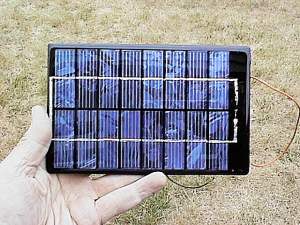
It is rugged and waterproof and has a fiberglass backing. This one cost me only $4.00!
The next one is a 14 volt 250 ma panel made by Solarex (now BP Solar). This one could be used for most charging applications specifically in the field. I use it to charge up my 4 watt VHF walkie-talkie when I'm in the woods back packing or out camping. It has an aluminum backing which makes it very rugged. I think I paid $18.00 for it, used.
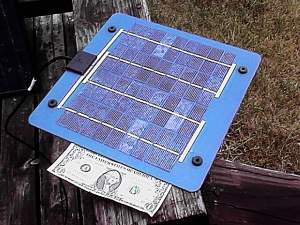
Note the size. It can just fit into a backpack.
I have a small Radio Shack AM/FM/SW all band radio that runs on solar power using an Amorphous glass panel.
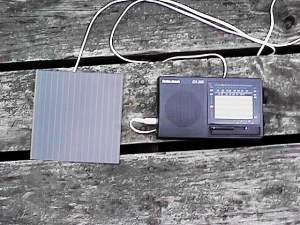
The glass panel is fragile and I need to put a stiff back board on it to protect it from breaking if dropped. I've heard that if it gets wet, the amorphous deposit on the back will dissolve and render it useless.
If you are really serious about solar power, the one below is one of 40 panels that run my house.
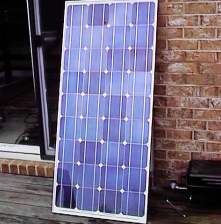
This panel can put out about 110 watts in direct sun. That's about 21 volts at 6.5 amps! New, they are about $650.00.
Below is my house in Virginia with a portion of the array installed. Right now it produces about 3.3kw or 300 amp/hours per day @ 53.2 volts, roughly 15.6 kwh per day. I'm planning another array behind this one that will give me a total capacity of 32 kwh per day. Enough to run the central air during the summer.
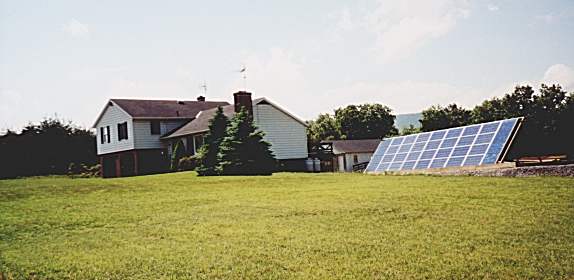
Below is a system at a friend's house in Cross Junction, Virginia. It provides about 2000 watts continuous output.

Let's talk about chargers
Do you really want to think about a bike generator?
Chargers, Controllers, Battery eliminators
Some good solar energy links. Some are very technical. Don't get lost.
For any technical questions or suggestions, you may email me, Rick,
and I would be
happy to try and answer them.
Please email me and let me know if any info here is worth my time
and effort or if you found any of it interesting. Thanks.